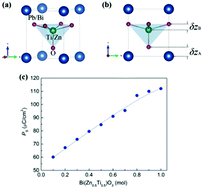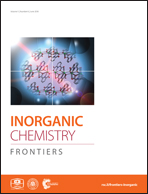Large spontaneous polarization in polar perovskites of PbTiO3–Bi(Zn1/2Ti1/2)O3†
Abstract
PbTiO3–Bi(Zn1/2Ti1/2)O3 is considered to be a promising high-ferroelectric performance material in the Pb/Bi-based perovskite family. In the present study, a whole set of (1 − x)PbTiO3–xBi(Zn1/2Ti1/2)O3 (0 ≤ x ≤ 1) solid solutions have been prepared by the conventional solid-state and high-pressure vs. high-temperature methods. The effect of Bi(Zn1/2Ti1/2)O3 on the crystal structure has been investigated by synchrotron X-ray powder diffraction. Unlike most PbTiO3-based perovskites, the present system exhibits a continuously enhanced tetragonality (c/a) and large spontaneous polarization (PS) properties. The enhanced c/a is ascribed to the large spontaneous polarization displacements induced by the strong Pb/Bi–O hybridization and coupling interactions between Ti/Zn and Pb/Bi cations, which can be evidenced from the lattice dynamics study and first-principles calculations. Accordingly, the TC (i.e., x = 0.5) is expected to be approximately 1000 °C if its perovskite structure can be stabilized. The present study provides a route to obtain large-PS in PbTiO3-based ferroelectric materials by introducing isostructural perovskites with strong polarity.

- This article is part of the themed collection: Inorganic Chemistry Frontiers HOT articles for 2018


 Please wait while we load your content...
Please wait while we load your content...